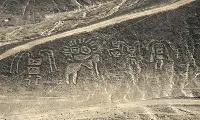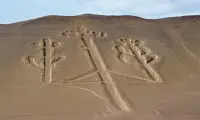Palpa Lines: Signs of Ancient Times in Peru
The Palpa Lines are a series of about 1,600 geoglyphs–collections of lines inside which show recognizable figures like humans and geometric shapes–that were carved into hillsides and desert areas several hundred years ago in what is now Peru. The Paracas culture flourished in the area from about 500 B.C. to about A.D. 200. The more famous Nazca culture gained dominance in the area after that; bridging the two was the mysterious Topará culture, about which little is known. The Paracas people lived in both the Palpa and Nazca regions. Like their successors the Nazca, the Paracas created large shapes bordered by lines. The Nazca Lines are thought to be more exotic and mysterious because they can be seen only from a great height, like from an airplane. The Palpa Lines, however, were, in many cases, carved into hillsides and can be seen from what would have been villages below. One of the most famous collections of Palpa Lines depicts what has been called La Familia Real, or Royal Family. The eight figures include what look to be adults, one younger human (perhaps a child), and what looks to be an animal. Another intriguing Paracas creation has been termed the Candelabrum. It appears to resemble its namesake and can be seen from 12 miles out to sea. One of the more intriguing Palpa Lines is known as the Ancient Mandala, or the Sun Star. Carved with precision, round figure is 180 feet in diameter and has an inner circle within it and is accompanied by several smaller circular figures nearby. All are on top of a mountain. A Peruvian archaeologist rediscovered the Palpa Lines in the 1920s; since then, archaeologists have mapped a good amount of the area but think that think more could be waiting to rediscovered. In 2018, scientists employing low-flying drones discovered a number of barely visible lines to add to the Palpa collection.
|
|
Social Studies for Kids
copyright 2002–2025
David White







